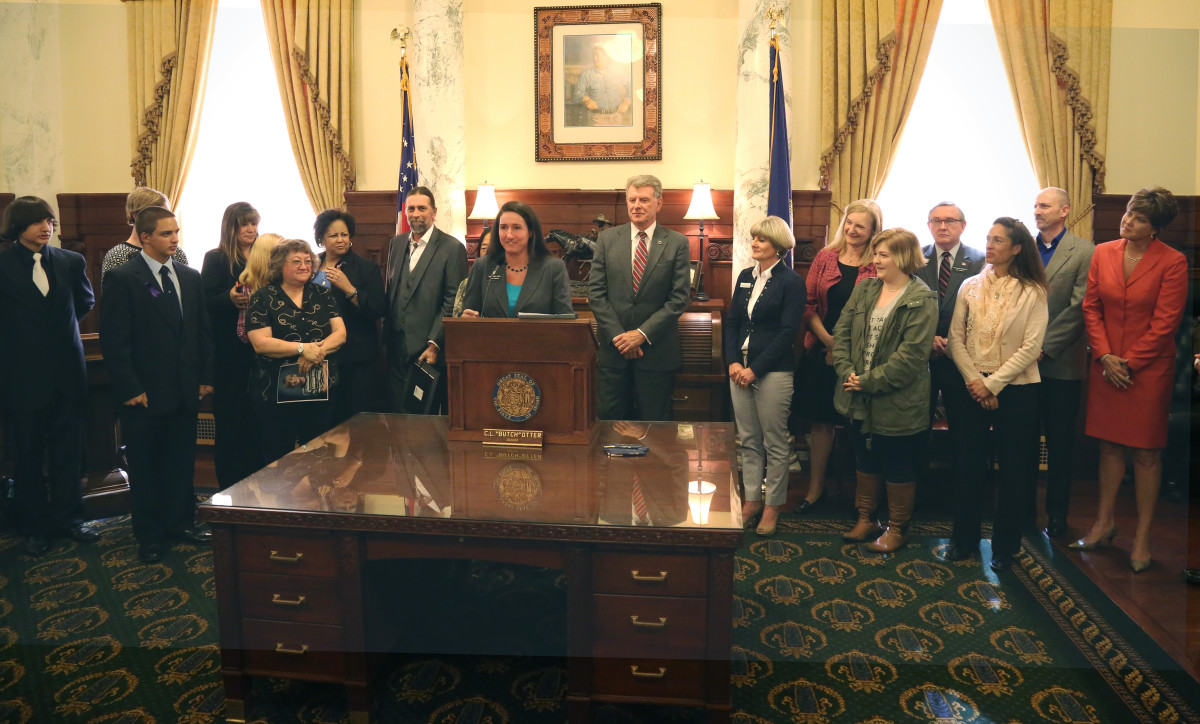
Idaho Gov. Butch Otter signed an anti-bullying bill into law, with much celebration, six years ago.
Lawmakers, parents and students crowded into Otter’s office to celebrate the law they considered overdue, EdNews reported at the time. The law required school districts to train staff on how to identify and respond to bullying and harassment, required districts to write a policy outlining the consequences to bullying, and required districts to report instances of bullying and harassment to the State Department of Education.
From the outset, the numbers reported by districts were surprisingly low — and the latest release of bullying data shows the most minuscule numbers yet. Idaho administrators reported only about 1,750 incidents of bullying or harassment among more than 300,000 youth during the 2019-20 school year.
Bullying by year: 3,162 reports in 2015-16, 3,578 reports in 2016-17, 3,322 in 2017-18, 2,023 in 2018-19 and only 1,750 incidents in 2019-20.
The numbers, if there was one bullying incident per student, would mean about .5% of Idaho students were bullied that year. But state and national student surveys suggest that number could be closer to 20%.
Idaho’s two biggest school districts, Boise and West Ada, reported only dozens of bullying cases in 2019-2020.
- West Ada, which had more than 40,000 students that year, reported only 22 instances of bullying.
- Boise, with over 25,000 students, reported 47.
“Just because we have 22 incidents doesn’t mean we don’t take it seriously and work to do better,” West Ada spokeswoman Char Jackson said in an email.
Communications staff in both districts pointed out that the numbers could be lower in the 2019-20 school year because of school closures forced by the pandemic. Three quarters of the school year was business-as-usual before students were sent home in late March due to the threat of the coronavirus.
The SDE relies on districts to report their own bullying data, as required by Otter’s 2015 law. The department does not independently verify district’s numbers, spokeswoman Kris Rodine said in an email.
And the numbers reported to the department vary widely. The highest bullying count in 2019-20 came from the Nampa School District, where administrators reported about 130 instances among 15,000 students.
Eighty-five districts and charters reported fewer than five cases.
And more than thirty districts don’t appear to have submitted bullying data at all. There are no penalties for a district that fails to comply with the state reporting law, Rodine said, “but one consequence might come from feedback from district parents or the public who know the data is required to be publicly reported.”
“It’s up to the local district to adopt their policies and the administrative procedures to support those policies. Naturally there will be variation in the numbers that get reported to us,” said Eric Studebaker, Student Safety and Engagement Director for the SDE.
Children report different numbers.
The Centers for Disease Control administers a regular survey to youth across the nation called the Youth Risk Behavior Surveillance System. On Idaho’s latest survey, from the spring of 2019, 21% of high school students reported being bullied on school property over the past 12 months.
A 2019 federal report called the Indicators of School Crime and Safety mirrors that. One in four high school students said they were bullied on school grounds, one in five reported bullying online, and Idaho’s bullying rates increased from 2011 to 2017, while national rates decreased.
When asked about the huge variation between the numbers reported by districts, and the numbers reported by students, Studebaker said: “That’s a good thing to talk about. Why don’t those numbers align more closely?”
Andy Grover, former Melba superintendent and president of the Idaho Association of School Administrators, thinks that discrepancy could have to do with the definition of bullying.
The state defines bullying as “intentional, repeated hurtful acts, words or other behavior such as name-calling, threatening and/or shunning.” It requires districts to report any such incidents that result in a “formal response,” like a meeting with administrators or a detention.
“If you have someone say something not nice to someone else, kids will consider that bullying, when maybe it’s not,” Grover said. “It’s all about what you perceive as bullying.”
Even the SDE’s definition of bullying could vary by individual interpretation, leading to a wide spread in the numbers from district to district, Grover said.
“The idea behind (the 2015 reporting law) I think is sound, we want to be able to make sure we’re protecting our kids and that school is a safe place to be,” Grover said. “I think the hard thing is, is defining what bullying is and what it isn’t. That’s always the catch.”
Corralling and publishing reliable numbers has also been a struggle with this particular data set.
According to the SDE, the second highest bullying number in the state came from the Salmon School District, a rural 750-student district near the Montana border. It reported 121 cases of bullying to the state in 2019-20, the state confirmed.
But in a phone call last week, Salmon Superintendent Chris Born said he didn’t think that number was accurate. His district probably had fewer than 5 bullying cases, he said. Born said he would need to circle back to his principals and make sure the district had reported that data correctly.
Despite the reporting discrepancies, Born thinks Otter’s 2015 law increased districts’ focus on bullying.
“Anytime that you get those legislative things handed down it does make you look back at what your processes and procedures are,” Born said. “I think that’s always the case.”
But like crimes, Born said, it’s probably true that bullying is under-counted in Idaho, based on the number of students who chose to report.
“That’s the problem with all crime in the United States, is the reporting of it…because of the stigma we attach to some of those crimes,” Born said. “I would assume the bullying in particular schools is no different.”
